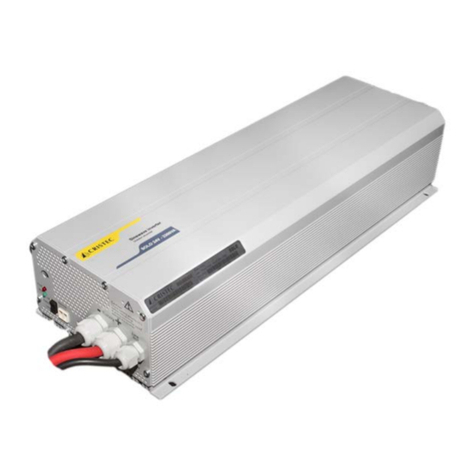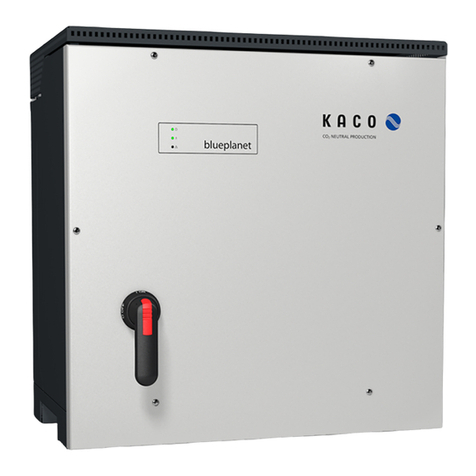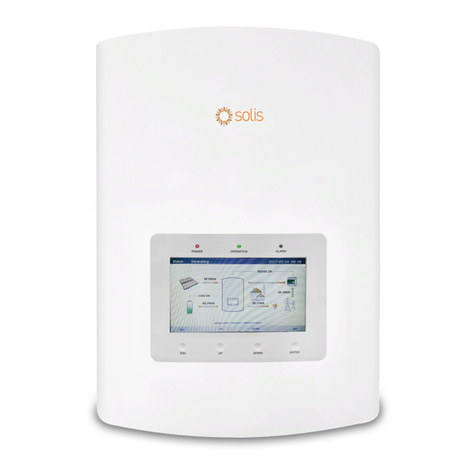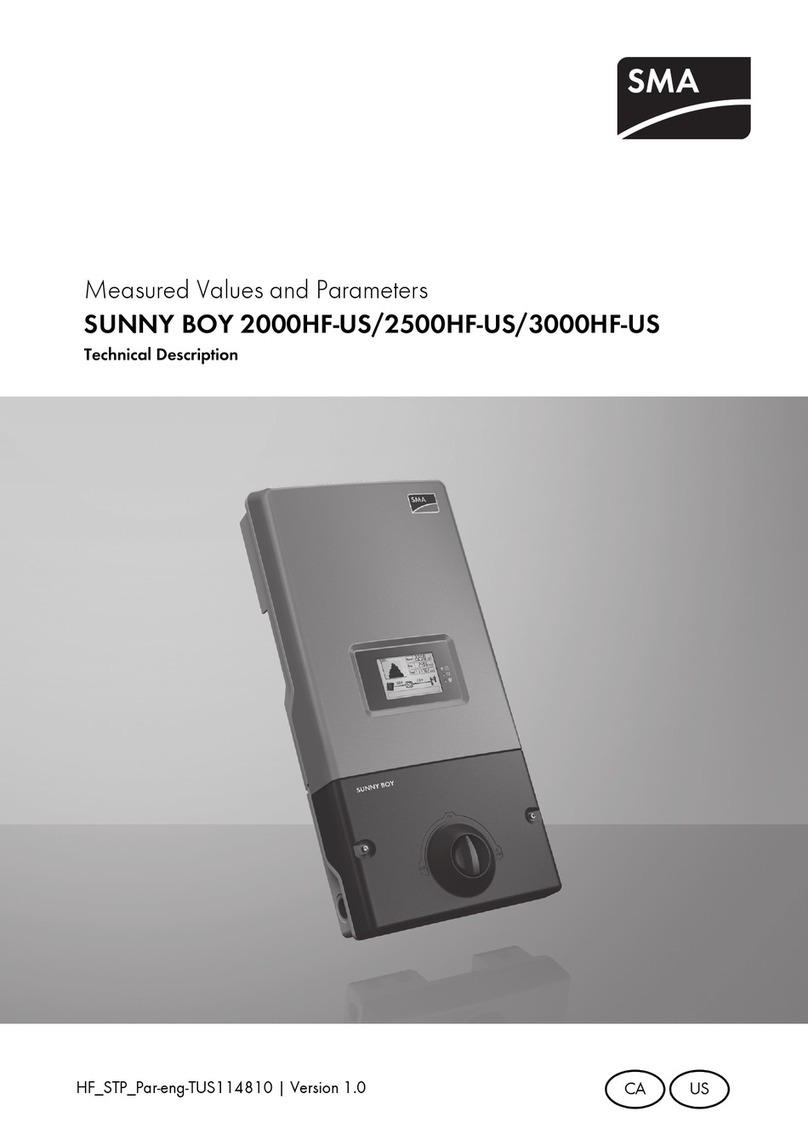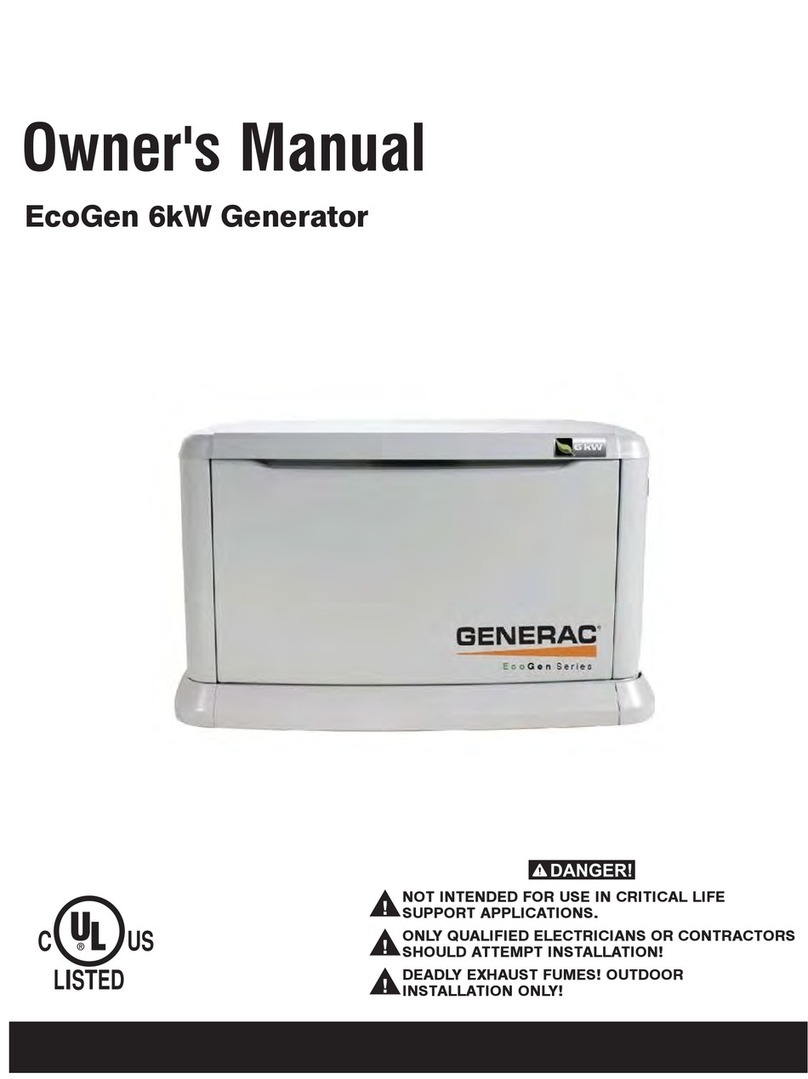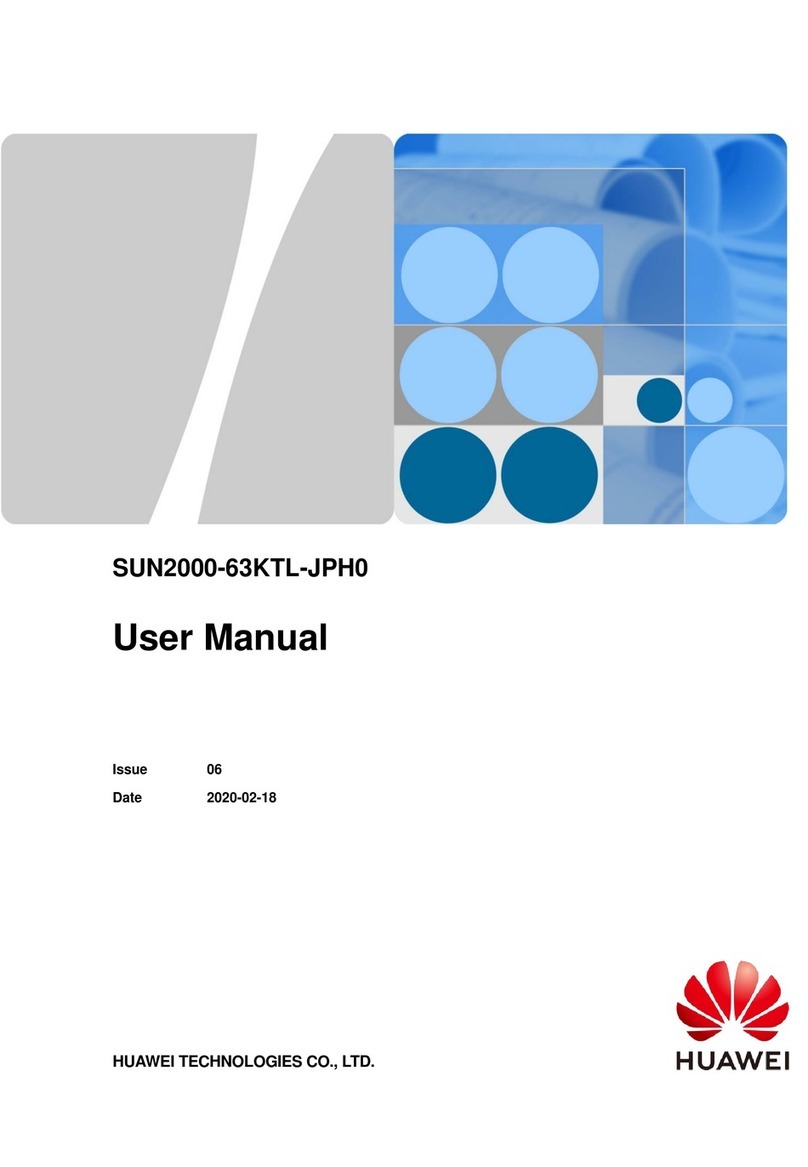Cristec SOLO Series Use and care manual

SOLO1DEE 30015171
SOLO series
SOLO 12V 200W
SOLO 24V 300W
SOLO 48V 300W
SOLO 12V 400W
SOLO 24V 500W
SOLO 48V 500W
SOLO 12V 800W
SOLO 24V 1000W
SOLO 12V 2000W
SOLO 24V 2000W
Manuel d’utilisation et de montage
User’s and Installer’s Manual
Betriebs-und Montageanleitung
Manual de utilización y montaje
ONDULEUR SINUSOÏDAL - SINEWAVE INVERTER
SINUS-WECHSELRICHTER – ONDULADOR SINUSOIDAL

SOLO1DEE Page 2 / 32

SOLO1DEE Page 3 / 32
INSTRUCTIONS EN FRANÇAIS
INTRODUCTION 4
MISE EN GARDE 4
INSTALLATION 4
UTILISATION 6
MODELES AVEC STANDBY 6
SECURITES 7
MAINTENANCE 7
EXCLUSION DE LA GARANTIE: 7
EXCLUSION DE LA RESPONSABILITE 8
CARACTERISTIQUES TECHNIQUES 9
ENGLISH DESCRIPTION
INTRODUCTION 10
NOTE 10
INSTALLATION 10
USE 12
MODELS WITH STANDBY SYSTEM 12
SAFETY 12
MAINTENANCE 13
WARRANTY LIMIT 13
LIMITS OF MANUFACTURER RESPONSIBILITY 14
TECHNICAL FEATURES 15
DEUTSCHE BESCHREIBUNG
EINFÜHRUNG 16
VORSICHT 16
INSTALLATION 16
ANWENDUNGEN 18
STANDBY ODER LASTERKENNUNGSSCHALTUNG 18
SICHERHEITEN 18
UNTERHALT 19
HAFTUNGSAUSSCHLUSS 20
TECHNISCHE DATEN 21
INSTRUCCIONNES EN ESPANOL
INTRODUCCION 22
ATENCION 22
INSTALACION 22
APLICACIONES 24
MODELOS CON STAND-BY 24
SEGURIDAD 25
MANTENIMIENTO 25
EXCLUSION DE LA GARANTIA 25
EXONERACION DE RESPONSABILIDAD 26
CARACTERISTICAS TECNICAS 27
DECLARATION OF CONFORMITY 32

SOLO1DEE Page 4 / 32
Instructions en français
Introduction
Les onduleurs de la série SOLO ont été conçus de manière à répondre aux besoins tant industriels que domestiques. Ils satisfont
aux plus hautes exigences de confort, de sécurité et de fiabilité.
Chaque appareil conçu pour le réseau électrique 230 V 50 Hz peut s’y brancher sans aucun problème jusqu'à la puissance
nominale de l’onduleur SOLO.
La série SOLO est la solution idéale comme source de tension partout où le réseau public n’est pas présent.
Ce document fait partie intégrante de l’onduleur, il doit être transmis à chaque livraison et tenu à disposition de toute personne
travaillant sur l’installation.
En cas de doute ou de question, n’hésitez pas à contacter votre vendeur spécialisé qui saura vous renseigner.
Mise en garde
Un montage incorrect peut endommager l’appareil, entraîner un mauvais fonctionnement ou mettre en danger les utilisateurs.
L’appareil en fonction génère de hautes tensions pouvant être fatales en cas de contact. Le travail sur l’onduleur doit faire l’objet
d’une attention toute particulière. Les installations doivent être exécutées par du personnel compétent et répondre aux normes en
vigueur.
AUCUNE PIECE A L’INTERIEUR DE L’ONDULEUR NE DOIT ETRE MANIPULEE PAR L’UTILISATEUR.
L’ouverture de l’onduleur ou l’utilisation non conforme de l’onduleur entraîne la perte immédiate de la garantie.
SOLO est prévu pour une alimentation avec des batteries à plomb uniquement.
Aucun appareil générateur de courant ou de tension ne doit être connecté à la sortie de l’onduleur car il peut entraîner la
destruction de celui-ci (réseau public, génératrice, ... ).
Pour l’utilisation des batteries, veuillez vous conformer aux directives d’utilisation du fabricant.
Installation
L’onduleur sinusoïdal SOLO est un appareil électronique ; quelques précautions sont nécessaires lors de sa mise en service :
Lieu de montage de l’onduleur
A l’abri des personnes non autorisées, spécialement des enfants.
Dans une pièce sèche (max. 95 % d’humidité) et dans tous les cas sans condensation.
Pas directement au-dessus des batteries.
L’aération ne doit pas être obstruée et une distance de 10 cm de chaque côté est nécessaire à la bonne évacuation de la chaleur
interne.
Fixation de l’onduleur
L’onduleur peut être fixé à l’aide de vis de 4 mm de diamètre maximum, pour les SOLO 200/300/400/500/800/1000Wet de vis de
8mm maximum pour les SOLO 2000W, dans les quatre rainures prévues à cet effet. Les vis de fixation ne sont pas fournies avec
l’onduleur.
La position de l’onduleur n’est pas importante : elle peut être murale, de table ou suspendue.
SOLO 200/300
L=163mm
SOLO 400/500
L=240mm
SOLO 800/1000
L=428mm
SOLO 2000
L=399mm

SOLO1DEE Page 5 / 32
Raccordement
Le raccordement doit être l’objet d’une attention toute particulière. De celui-ci dépend le bon fonctionnement de toute
l’installation. Les données techniques ou la description de raccordement se trouvent soit sur un des côtés inférieurs de l’appareil ou
du côté de l’embranchement du câble. Raccordez d’abord les consommateurs ou montez une prise de manière à éviter tout contact
ultérieur une fois la tension 230 V présente. L’installation doit être exécutée par les personnes autorisées.
Raccordement des consommateurs
L’onduleur SOLO est livré avec le câble 230 V pour alimenter les consommateurs. Celui-ci doit être raccordé en respectant les
couleurs :
Jaune-vert : Terre
Brun : Phase
Bleu : Neutre
Une fois les consommateurs raccordés, veillez à ce qu’ils soient éteints avant de brancher la batterie.
Remarque :
Un onduleur constitue une source de tension indépendante du réseau à considérer de la même manière qu’une génératrice. La
phase et le neutre présentent une tension de 230Ventre eux. La tension terre / neutre et phase / neutre et fixée à 115V par un
diviseur capacitif. Selon les prescriptions locales ou les besoins, (par exemple utilisation d’in disjoncteur à courrant de défaut) un
équipotentiel terre / neutre est réalisé en reliant ensemble les fils neutre et terre(jaune – vert et bleu).
Schéma équivalent
Raccordement de la batterie
Assurez-vous qu’aucun contact avec des personnes ne soit possible sur le coté 230 V avant de raccorder la batterie.
Le câble de la batterie est livré avec l’onduleur et est déjà raccordé à l’intérieur de celui-ci.
Raccordez la batterie en faisant très attention à la polarité. L’onduleur, est protégé de l’inversion de polarité par un fusible, à
l’exception du SOLO 2000W/12V. Cependant, si la polarité est inversée, l’onduleur doit être retourné en usine pour contrôle.
Raccordez la batterie en utilisant les câbles aux couleurs suivantes :
Câble NOIR : Pôle négatif (-)
Câble ROUGE : Pôle positif (+).
Pour SOLO 200/300W appliquer la couleur dominante comme couleur de référence.
(absent dans les modèles SOLO 12V/200W, SOLO 24V/300W, SOLO 48V/300W)

SOLO1DEE Page 6 / 32
En branchant la batterie il y a une étincelle (Danger d’explosion !), en raison du chargement du condensateur interne. Un fusible
de sécurité incendie doit être monté sur la batterie.
Vérifiez le serrage des câbles.
Dans la mesure du possible ne rallongez pas les câbles de batteries fournis. Le fait de rallonger les câbles de batterie peut
augmenter les pertes et provoquer un dysfonctionnement de l’onduleur.
Une fois l’onduleur branché sur la batterie, la tension 230Vest présente à la sortie de l’onduleur.
Utilisation
Commande et indicateurs
Bouton de commande on/off
Un bouton de commande est accessible sur l’onduleur. Il permet de l’enclencher ou de le déclencher. Utilisez cette fonction pour
économiser l’énergie des batteries lorsque vous n’utilisez pas l’onduleur.
Indicateur vert
Un indicateur lumineux vert placé sur l’onduleur indique le mode de fonctionnement :
Eteint : La tension 230 V n’est pas présente à la sortie ; l’onduleur est éteint.
Allumé : La tension 230 V est présente à la sortie ; l’onduleur est en fonction.
Clignotant :
L’onduleur est en mode stand-by.
La tension 230Vest coupée momentanément suite à une alarme ; l’onduleur se remettra
automatiquement en fonction dès que l’alarme aura disparu. (voir tableau des fautes ci-dessous)
Indicateur sonore
L’onduleur SOLO dispose d’un indicateur sonore qui signale les cas suivants :
•Son intermittent :
L’onduleur est en présence d’une faute et va couper la tension de sortie.
Fautes possibles :
Surchauffe : l’indicateur sonne 3°C avant l’arrêt de l’onduleur. Diminuez la charge afin d’abaisser la température de l’onduleur et
ainsi éviter l’arrêt.
Sous tension de batterie : l’indicateur sonne une minute avant la coupure. Si la tension de batterie remonte, la tension de sortie
n’est pas coupée.
•Son continu de deux secondes :
Vous avez appuyé sur le bouton ON/OFF pour redémarrer l’onduleur. La tension de sortie est immédiatement présente à la sortie
après le signal sonore.
Modèles avec STANDBY
Les onduleurs SOLO d’une puissance de 400/500W et plus sont équipés d’un système stand-by.
Le stand-by est un système d’économie d’énergie qui déclenche l’onduleur par intermittence lorsque aucun consommateur n’est
détecté. Dans ce mode, l’indicateur lumineux vert clignote, indiquant la présence par intermittence de la tension.
La puissance minimale détectée peut être ajustée entre 1 et 20W.
Dans la plupart des installations, ce réglage n’est pas utile.
Le réglage se fait à l’aide d’un tournevis plat n°1 dans l’ouverture notée stand-by sur l’onduleur. Dans la position maximale à
droite, la sensibilité est minimale (20W). Ne pas appuyer sur le tournevis.
ATTENTION : en fonctionnement stand-by le 230V est présent par intermittence à la sortie.

SOLO1DEE Page 7 / 32
Sécurités
L’onduleur SOLO est protégé de manière électronique. Il est protégé contre les inversions de polarité par un fusible interne, à
l’exception du modèle 2000W/12V. Le tableau ci-dessous donne les divers cas possibles de faute et les conséquences.
.FAUTE CONSEQUENCE RESOLUTION
Tension de batterie
basse
<1,8V/élément
Onduleur stoppé
momentanément, l’indicateur
vert clignote.
Démarrage automatique dès que la tension de batterie sera remontée
à 2V/élément
Tension batterie
<1,5V/élément
Onduleur stoppé
indicateur vert éteint
Redémarrage manuel possible dès que la tension batterie est
=/>2V/élément
Surchauffe Onduleur stoppé momentanément,
l’indicateur vert clignote.
Démarrage automatique dès que la température de l’appareil aura
baissé.
Surtension de batterie Onduleur stoppé Attendez que la tension de batterie soit à nouveau correcte. Une
tension trop élevée peut détruire l’onduleur. Appuyez sur le bouton
ON/OFF pour redémarrer l’onduleur.
Court-circuit en sortie Onduleur stoppé Supprimez le court-circuit.
Appuyez sur le bouton ON/OFF pour redémarrer l’onduleur.
Surcharge Onduleur stoppé Utilisez l’onduleur dans les limites de sa puissance nominale. Une
utilisation prolongée ou régulière en surcharge diminuera sa durée
de vie. Appuyer sur le bouton ON/OFF pour redémarrer l’onduleur.
Inversion de polarité
de la batterie
Fusible interne détruit Retour en usine pour test.
Maintenance
Les onduleurs de la série SOLO ne nécessitent aucun entretien particulier. Le boîtier peut être nettoyé avec un chiffon humide (pas
mouillé).
Si un dysfonctionnement ou une déformation mécanique de la boite ou des câbles devait apparaître, l’onduleur doit être envoyé,
soigneusement emballé dans son emballage d’origine, au fournisseur pour contrôle.
Avant d’envoyer l’onduleur, veuillez contrôler les points ci-dessous.
•La batterie est chargée et correspond à la tension nominale d’entrée de l’appareil.
•Les consommateurs ne présentent aucun défaut ou surcharge pour l’onduleur. (Pour s’en assurer, débrancher les
consommateurs).
Si toutefois vous devez prendre contact avec votre revendeur, veuillez noter les points suivants avant d’appeler :
(vous trouverez ces indications sur l’étiquette au dessous de l’onduleur ou du côté de l’embranchement du câble)
•Le type exact de l’onduleur
•Le numéro de série
•La puissance de l’onduleur
•La tension nominale d’entrée de l’onduleur
•Avant l’envoi de l’onduleur, veillez qu’il soit bien emballé, l’onduleur doit être mis dans un carton rigide et être bien protégé
de tous côtés ainsi que dessous, d’une couche d’isolante anti-choc d’au moins 20mm d’épaisseur. Une mauvaise protection peut
causer des dommages à l’onduleur lors du transport.
•Les dégâts causés lors du transport ne sont pas couverts par la garantie.
Vous obtiendrez ainsi une aide rapide et efficace pour la résolution de votre problème.
Exclusion de la garantie (2 ans) :
La garantie CRISTEC ne couvre pas ses produits dans les cas de défauts survenus lors d’un usage non conforme à la description
du manuel d’instructions ou non décrit par celui-ci, ou de tout autre usage inapproprié, notamment pour les onduleurs les
événements suivants :
Inversion de la polarité sur l’entrée batterie.
Tension inappropriée sur les entrées (surtension).
Mise en contact de la sortie avec une autre source de tension tel que réseau public ou générateur.
Déformation mécanique.
Mise en contact avec un liquide ou oxydation due à la condensation.
Usage dans un environnement inadéquat. (poussières, vapeur corrosive, humidité, température élevée, etc.)

SOLO1DEE Page 8 / 32
Exclusion de la responsabilité
La pose, la mise en fonction, l’utilisation, la maintenance et le service ne peuvent pas faire l’objet d’une surveillance par la société
CRISTEC. Pour cette raison, nous déclinons toute responsabilité pour les dommages, les coûts ou les pertes résultants d’une
installation non conforme aux prescriptions, d’un fonctionnement défectueux ou d’un entretien déficient.
L’utilisation des onduleurs CRISTEC relève dans tous les cas de la responsabilité du client.
Cet appareil n’est pas conçu ni garanti pour l’alimentation d’installations destinées à supporter la vie ou toute autre installation
critique comportant des risques potentiels de dégâts à l’homme ou à l’environnement. Nous n’assumons en outre aucune
responsabilité pour les violations de droits de brevets ou d’autres droits de tiers résultant de l’utilisation de l’onduleur.
CRISTEC se réserve le droit de toute modification sur les produits sans communication préalable
CDPS Commande à distance pour SOLO 800/1000 & 2000
Les fonctions de la télécommande sont les mêmes que les fonctions disponibles sur
l’onduleur.
La télécommande doit être raccordée à l’onduleur à l’aide du câble d’origine
CRISTEC (10m) ou tout autre câble RJ11/6p 1:1 jusqu’à une longueur max. de
50m.

SOLO1DEE Page 9 / 32
Caractéristiques techniques
SOLO 200/300 SOLO 400/500
TYPE SOLO 12V
200W
SOLO 24V
300W
SOLO 48V
300W
SOLO 12V
400W
SOLO 24V
500W
SOLO 48V
500W
Tension de batterie (V) 12 24 48 12 24 48
Tension admissible (V) 10.5 - 16 21 - 32 42 - 64 10.5 - 16 21 - 32 42 - 64
Puissance Nominale/Instantanée(5s)/
Maximum(30mn) en W
200/275/450 300/350/650 300/400/1000 400/500/1000500/600/1200 500/700/1400
Consommation Stand-by / ON en W - / 1.9 - / 3.3 - / 7.2 0,3 / 3,8 0.4/ 8,5 1/ 10
Rendement maximal en % 93 94 94 93 94 94
Dim. 142 x 84 x L( mm) L= 163mm 240mm
Poids en kg. (approx.) 2.4 2.6 2.6 4.5
Commande à distance (option) non non
Système stand-by (1 à 20 W) non
SOLO 800/1000 SOLO 2000
TYPE SOLO 12V
800W
SOLO 24V
1000W SOLO 12V
2000W
SOLO 24V
2000W
Tension de batterie (V) 12 24 12 24
Tension admissible (V) 10.5 - 16 21 - 32 10.5 - 16 21 - 32
Puissance Nominale/Instantanée(5s)/
Maximum(30mn) en W
800/1000/2200 1000/1300/2800 2000/2100/5000 2000/2400/5200
Consommation Stand-by / ON en W 0,3 / 9 0,4 / 10 0.5 / 13 0.4 /18
Rendement maximal en % 93 94 92 94
Dim. 142 x 84 x L( mm) L= 440mm 273 x 415 x 117mm
Poids en kg. (approx.) 8,5 19 18
Commande à distance (option)
Système stand-by (1 à 20 W)
Tension de sortie Sinus 230V +/-5% (120V +/-5%)
Fréquence 50 Hz +/- 0.05 % (60 Hz +/-0.05%)
Ventilation Dès 45° C
Protection thermique
Protection surcharge
Protection court-circuit
Degré de protection aux intempéries IP 30 (SOLO 2000 = IP 20)
Cos ϕ0.1-1

SOLO1DEE Page 10 / 32
English description
Introduction
The sine-wave inverters of the SOLO series have been designed to meet industrial and domestic needs. They fulfil the
highest requirements of comfort, safety and reliability.
Any device designed for the public electrical network of 230V 50 Hz can be connected to them (up to the nominal
power of the inverter).
The SOLO series is the perfect source of tension in any place where the public network is not available.
This document is an essential part of the inverter and must always be carried with it and be at the disposition of anyone
working on the installation.
Should you have any doubt or question, do not hesitate to contact your specialist salesperson who will give you the best
advice.
Note
A deficient assembly could result in damage to the device, cause function failures or potential damage to the users.
The working device generates a high tension which might be fatal in case of contact. So, any manipulation of the
inverter must be carried out with utmost care.
THE OWNER MUST NOT MANIPULATE ANY PIECE INSIDE THE INVERTER.
Opening the inverter or using it incorrectly will result in the immediate loss of the warranty.
No current or tension generating devices (public grid, generator,...) may be connected to the outlet of the inverter
because this could result in its destruction.
The inverter SOLO is to be used only with a lead battery. As for the usage of batteries, follow the manufacturer’s
instructions.
Installation
The SOLO sine-wave inverter is an electronic device, for which some caution must be taken when installing it:
Place where the inverter is to be installed :
•Out of reach of unauthorised persons, especially children.
•In a dry place (max. 95% humidity), and in any case with no condensation.
•Not directly on top of the batteries.
•Ventilation must be free, and a space of 10 cm. on each side is needed for good evacuation of the internal heat.
Fitting the inverter
The inverter is fitted by screws (max. 4mm for SOLO 200/300/400/500/800/1000W or max. 8mm for SOLO 2000W)
using the four holes provided. The fitting screws are not supplied with the inverter.
It may be fit into any position.
SOLO 200/300
L=163mm
SOLO 400/500
L=240mm
SOLO 800/1000
L=428mm
SOLO 2000
L=399mm

SOLO1DEE Page 11 / 32
Connection
The connection of the inverter should be done with utmost care. First connect the consumer devices so as to prevent any
further contact once the 230V tension is present. The technical data and connection’s description, is either under one
side of the inverter or onto the cable connection side. Installation is to be made only with authorised persons.
Connecting the consumer devices
The SOLO inverter is supplied with a 230V cable for the consumer devices. This connection must be done observing
the colours:
Yellow-green: earth
Brown: phase
Blue: neutral
Once the consumer devices are connected, make sure that they are turned off before connecting the battery
Note
An inverter constitutes an independent power supply from net and could be considered in the same way as a generator
set. The phase and the neutral are not differentiate. The tension in between the phase and the neutral is 230V. An
appropriate divisor establishes a 115V voltage in between neutral and earth, and the phase and earth. According to the
local prescriptions or particular requirement, (example: use of a ground fault detector) a true neutral may be established
by connecting the neutral and the earth wire together. The so connected point, may be connected with an existing earth:
earth of building; the chassis of vehicle or the hull of ship.
Equivalent schema
Connecting the battery
Once the consumer devices are connected, make sure that the installations instructions of the 230V has been followed
with utmost care before connecting the battery.
The cable of the battery is supplied with the inverter and already connected in it.
A fuse must be installed on the battery.
Connect the battery observing carefully the polarity. The SOLO inverter, except 2000W/12V,is protected against
inversion by a fuse, but if the polarity should be inverted, the inverter must be sent to the manufacturer for control.
Connect the battery using the following colours:
BLACK cable: negative pole (-)
RED cable: positive pole (+)
For SOLO 200W/300W, dominant colour is applicable
(
not existin
g
in SOLO 12V/200W
,
SOLO 24V/300W
,
SOLO 48V/300W
)

SOLO1DEE Page 12 / 32
When connecting the battery, there’s a spark (Danger of explosion!), because of the charging of the internal capacitor.
Check that the cables are well adjusted. As long as it is possible, do not extend the cables supplied with the batteries.
Extending them may increase the losses and cause malfunction of the inverter.
Once the inverter is connected to the batteries, a 230 V tension is present in the outlet of the inverter.
Use
Control and indicators
Control switch on/off
There is a switch on the inverter to activate or deactivate it. Use this function to save the energy of the batteries when
you are not using the inverter.
Green indicator
A green light on the inverter indicates its function mode:
Off: the 230V tension is NOT present in the outlet, the inverter is off.
Illuminated: a 230V tension is present in the outlet, the inverter is on.
Blinking:
No load (standby)
the 230V tension has been cut due to an alarm; the inverter will resume function when the
failure has disappeared (see the failure table).
Acoustic indicator
The SOLO inverter has an acoustic indicator for the following instances:
Intermittent beep: there is a failure in the inverter and the outlet tension will be interrupted.
Possible failures:
Overheat: the acoustic indicator beeps 3 ºC before cutting the tension. If the temperature reaches its normal level, the
tension in the outlet is not interrupted.
Low battery tension: the indicator beeps for a minute before the interruption. If the tension of the battery rises, the outlet
tension is not interrupted.
Continuous beep for two seconds: you have pressed the ON/OFF switch to restart the inverter. The tension in the outlet
will be immediately present after the acoustic signal.
Models with standby system
The SOLO inverter with a power of 400W/500W and more are equipped with a standby system witch is in function
when no load is connected. In that situation the inverter is in low power consumption mode.
The output tension is not continuously present and the LED is blinking as long as no load is detected.
The minimal load detected can be adjusted between 1 and 20W. In most case this adjustment is not necessary. This
adjustment is made with a small screw driver in the hole marked standby. In the full counter clockwise position, the
sensibility is minimal (20W). Do not push on the screw driver.
NOTE : in this mode the output tension is intermittently present at the output
Safety
The inverter is electronically protected. But protection against polarity inversions of the battery occurs with an internal fuse,
except for 2000W/12V inverter, which has no fuse. The following table will show you the different failures and their
consequences.

SOLO1DEE Page 13 / 32
FAILURE CONSEQUENCE SOLUTION
Low battery tension
Voltage < 1.8V/cel
Inverter momentarily
stopped, the green indicator
blinks.
Automatic restart when the battery tension rises
Deep discharged battery
(voltage <1,5V/cel)
Inverter stopped Inverter should be manually restarted when the battery as
reach 2V/cel
Overheat Inverter momentarily
stopped, the green indicator
blinks.
Automatic restart when the temperature reaches the normal
range.
Battery over voltage Inverter stopped. Wait until the battery tension reaches the correct level.
Push the ON/OFF switch to reactivate the inverter.
Short circuit in the outlet Inverter stopped. Eliminate the short circuit.
Push the ON/OFF switch to reactivate the inverter.
Overload Inverter stopped. Use the inverter only in the range of its nominal power.
Regular use in overload power diminished the lifetime of the
inverter.
Push the ON/OFF switch to reactivate the inverter.
Inversion of the battery polarity Internal fuse broken down Back to manufacturer for testing
Maintenance
The inverters of the SOLO series do not need any special maintenance. The casing may be cleaned with a damp
cloth (not wet).
In the case of malfunction, the inverter should be sent back to the manufacturer for control in its original
packing.
Before sending the inverter, check the table above.
The battery is loaded and is in accordance to the inlet nominal tension of the device.
The consumer devices do not have any defects or overload for the inverter.
Should you contact your salesperson, note the following points before calling:
(you will find this information on the label underneath the inverter)
•Series number
•Power of the inverter
•Inlet nominal tension of the inverter
So you will have quick and efficient help to solve your problem.
Warranty limit (2 years)
•The warranty will be considered void if the unit has suffered any physical damage or alteration, either
internally or externally, and does not cover damage arising from improper use like:
•Reverse of battery polarity
•Inadequate input voltage (over voltage)
•Back-feed of the inverter output by public network, generator or any other source.
•Mechanical shock or deformation especially by transport due to an inappropriate package.
•Contact with liquid or oxidation by condensation
•Use in inappropriate environment (dust, corrosive vapour, humidity, high temperature,...)
•This warranty will not apply where the product has been misused, neglected, improperly installed, or
repaired by anyone other than CRISTEC or a company authorised by CRISTEC. In order to qualify for the
warranty, the product must not be disassembled or modified.

SOLO1DEE Page 14 / 32
Limits of manufacturer responsibility
CRISTEC cannot control the installation, use and maintenance of the inverter. Thus, we are not responsible for
damages, costs or losses resulting from an installation which is not in accordance with the regulations or
inappropriate use or maintenance.
The customer is always responsible for the use of the inverters CRISTEC.
This device has not been designed and is not warranted for use in life support apparatus or any other critical
device with potential risks of important harm to people or to the environment. We do not accept any
responsibility for any violation of patent rights or other third person rights resulting from the use of the inverter.
CRISTEC keeps the right to modify their products without previous notice.
CDPS Remote control for SOLO 800/1000 & 2000
•Functions on remote control are the same as control and indicator on the inverter.
Remote control should be connected with the inverter with the original 10m.
CRISTEC cable or any RJ11/6p 1:1 cable up to max 50m.

SOLO1DEE Page 15 / 32
Technical features
SOLO 200/300 SOLO 400/500
TYPE SOLO 12V
200W
SOLO 24V
300W
SOLO 48V
300W
SOLO 12V
400W
SOLO 24V
500W
SOLO 48V
500W
Battery tension (V) 12 24 48 12 24 48
Input voltage (V) 10.5 - 16 21 - 32 42 - 64 10.5 - 16 21 - 32 42 - 64
N
ominal power/Instant. Power (5s)/
Maximum Power (30mn) in W
200/275/450 300/350/650 300/400/1000 400/500/1000500/600/1200500/700/1400
Standby / Idle power (W) - / 1.9 - / 3.3 - / 7.2 0,3 / 3,8 0.4 / 8,5 1/ 10
Maximum efficiency (%) 93 94 94 93 94 94
Dim. 142 x 84 x L( mm) L= 163mm 240mm
Weight in kg. (approx.) 2.3 2.5 2.5 4.5
Remote control (optional) No No
Standby system (1 to 20W) No
SOLO 800/1000 SOLO 2000
TYPE SOLO 12V
800W
SOLO 24V
1000W SOLO 12V
2000W
SOLO 24V
2000W
Battery tension (V) 12 24 12 24
Input voltage (V) 10.5 - 16 21 - 32 10.5 - 16 21 - 32
N
ominal power/Instant. Power (5s)/
Maximum Power (30mn) in W
800/1000/2200 1000/1300/2800 2000/2100/5000 2000/2400/5200
Standby / Idle power (W) 0,3 / 9 0,4 / 10 0.5 / 13 0.4 /18
Maximum efficiency (%) 93 94 92 94
Dim. 142 x 84 x L( mm) L= 440mm 273 x 415 x 117mm
Weight in kg. (approx.) 8,5 19 18
Remote control Optional)
Standby system (1 to 20W)
Output tension Sine wave 230V +/-5% (120V +/-5%)
Frequency 50 Hz +/- 0.05 % (60 Hz +/-0.05%)
Ventilation From 45° C
Overheating protection
Overload protection
Short circuit protection
IP protection index IP 30 (SOLO 2000 = IP 20)
Cos ϕ0.1-1

SOLO1DEE Page 16 / 32
Deutsche Beschreibung
Einführung
Die Wechselrichter der Serie SOLO sind für den Betrieb von allen handelsüblichen 230V Geräten konzipiert worden. Die SOLO
genügen den höchsten Anforderungen an Zuverlässigkeit, Sicherheit und Komfort.
Jedes für das 230V-Wechselstromnetz geeignete Gerät kann auch mit einem SOLO betrieben werden.
Ein SOLO ist die ideale Spannungsquelle überall da wo das öffentliche Netz nicht hinführt.
Diese Beschreibung ist in jedem Fall Teil der Lieferung eines SOLO. Sie muss allen Personen welche mit einem SOLO arbeiten
zur Verfügung stehen !
Bei eventuellen Fragen oder Unklarheiten kann Ihnen der Händler Auskunft geben
Vorsicht
Eine falsche Behandlung oder Montage des Wechselrichters kann schwerwiegende Folgen haben !
Der SOLO erzeugt eine 230V-Sinusspannung wie im öffentlichen Stromnetz. Jegliche Berührung kann fatale Folgen haben ! Die
Installationsarbeiten mit dem Wechselrichter SOLO verlangen besondere Aufmerksamkeit und dürfen nur von geschultem
Personal ausgeführt werden und müssen in jedem Fall den jeweils gültigen Installationsvorschriften entsprechen.
Der SOLO darf in keinem Fall geöffnet werden.
Das Öffnen oder die nicht konforme Anwendung des SOLO bedeuten den Verlust jeglicher Garantieansprüche.
Der SOLO darf mit keiner anderen Spannungs- oder Stromquelle als mit Bleibatterien betrieben werden.
Am Ausgang des SOLO dürfen keine Spannungs- oder Stromquellen wie Notstromgeneratoren, das öffentliche Netz usw.
angeschlossen werden, da der Wechselrichter zerstört werden könnte.
Der Einsatz von Batterien verlangt besondere Vorsicht. Befolgen Sie darum unbedingt die Richtlinien des
Batterieherstellers.
Installation
Der Sinuswechselrichter SOLO ist ein elektronisches Gerät. Für dessen Installation sind darum einige Vorsichtsmassnahmen zu
beachten.
Der Montageort sollte gegen unbefugten Zugriff gesichert sein (vor allem auch vor Zugriff von kleinen Kindern)
In einem trockenen Raum mit einer Luftfeuchtigkeit von max.95% ohne Kondensation.
Nicht direkt über der Batterie.
Bei den Lüftungsein- bzw. Auslässen muss für eine unbehinderte Lüftung 10cm Freiraum belassen werden.
Befestigung des SOLO
Der Wechselrichter kann mit Hilfe von 4 Schrauben (Durchm. max. 4mm für SOLO 200/300/400/500/800/1000W oder Durchm.
max. 8mm für SOLO 2000W) in jeder beliebigen Lage montiert werden. Für die Befestigung dürfen nur die 4 von aussen
zugänglichen Löcher verwendet werden. Die Befestigungsschrauben sind nicht beigelegt.
SOLO 200/300
L=163mm
SOLO 400/500
L=240mm
SOLO 800/1000
L=428mm
SOLO 2000
L=399mm

SOLO1DEE Page 17 / 32
Anschluss
Der Anschluss des SOLO muss mit besonderer Vorsicht ausgeführt werden. Eine sichere und einwandfreie Funktion der Anlage
wird dadurch gewährleistet. Die Gerätedaten und die Anschlussbezeichnung befinden sich auf der Gehäuseunterseite oder auf
der Kabelanschlusseite. Vor dem Anschluss des SOLO an die Batterie muss das Kabel OUT 230V mit einer
Steckerkupplung(weiblich) versehen werden oder bei einer festen Installation muss der Anschluss entsprechend den
Installationsvorschriften von geschultem Personal ausgeführt werden.
Anschluss der Verbraucher
Der Wechselrichter SOLO wird mit bereits angeschlossen Kabeln geliefert. Das schwarze 3-adrige Kabel für den 230V-Ausgang
muss entsprechend den folgenden Farben angeschlossen werden.
Gelb-/Grün : Erdleiter
Braun : Phase
Blau : Neutral
Vor dem Anschluss der Batterie muss darauf geachtet werden, dass die angeschlossenen Verbraucher ausgeschaltet sind.
Bemerkung : Ein Wechselrichter ist eine vom Netz unabhängige Spannungsquelle Vergleichbar mit einem Notstromgenerator.
Phase und Neutralleiter können darum vertauscht werden. Zwischen Phase und Neutralleiter liegt die Spannung von 230V.
Zwischen Phase und Erde sowie zwischen Neutral und Erde liegen jeweils 115V an. Je nach Installationsvorschriften können
Neutralleiter und Erde verbunden werden.
Prinzipschema
Anschluss der Batterie
Vor dem Anschluss der Batterie muss sichergestellt sein, dass die 230V Installation vorschriftsgemäss ausgeführt wurde.
Der SOLO wird mit angeschlossen Batteriekabeln geliefert. Beim Anschliessen der Batterie muss unbedingt auf die richtige
Polarität geachtet werden. Die SOLO, mit Ausnahme des 2000W/12V, sind wohl durch eine Sicherung gegen Verpolung
geschützt. Für einen eventuellen Sicherungswechsel muss der SOLO zur Kontrolle an den zuständigen Händler gebracht werden.
Draht Schwarz:-Minus-Pol
Draht Rot : + Plus-Pol
Für die Kabel der SOLO 200/300W gelten die jeweils dominierenden Farben!
(
nicht aus
g
er. in SOLO 12V/200W
,
SOLO 24V/300W
,
SOLO 48V/300W
)

SOLO1DEE Page 18 / 32
Den SOLO an die Batterie anschliessen. Beim Anschliessen der Batterie entsteht ein Funken (EXPLOSIONSGEFAHR!)
wegen der Ladung der internen Kondensatoren. Die Batterie muss mit einer Sicherung auf der Batterieklemme versehen sein !
Kontrollieren Sie, dass die Anschlüsse gut festgeschraubt sind.
Die Batteriekabel sollten nicht verlängert werden. Eine Verlängerung der Batteriekabel bedeutet grössere Verluste und oder
Funktionsstörungen des SOLO und somit auch der angeschlossenen Geräte.
Sobald der SOLO an der Batterie angeschlossen wird, ist er eingeschaltet und es liegen 230V am Ausgang.
Anwendungen
Bedienung und Anzeigen
Steuertaste on/off
Mit der Drucktaste kann der SOLO ein- und ausgeschaltet werden. Schalten Sie den Wechselrichter mit dieser Taste aus, wenn
Sie keine Energie brauchen.
Grüne Leuchte
Eine grüne Leuchtdiode(LED) zeigt den Funktionszustand des Wechselrichters an.
LED leuchtet : Der Wechselrichter ist in Funktion - am Ausgang liegen 230V.
LED blinkt :
Der Wechselrichter ist im Standby-Betrieb.
Der Wechselrichter ist wegen eines Alarms vorübergehend ausgeschaltet. Nach verschwinden des
Alarms schaltet sich der Wechselrichter automatisch wieder ein. (Die möglichen Alarmgründe sind auf der folgenden
Tabelle aufgeführt.)
LED gelöscht : Der Wechselrichter ist ausgeschaltet, am Ausgang liegt keine 230V-Spannung.
Akustischer Signalgeber
Der Wechselrichter SOLO ist mit einem akustischen Signalgeber ausgerüstet welcher in folgenden Fällen
piept :
•Intermittierender Ton : Signal, dass der Wechselrichter sich im Alarmzustand befindet und demnächst die
Ausgangsspannung abschalten wird.
Mögliche Fehler : Überhitzung : Alarm 3°C bevor der Wechselrichter abschaltet. Einen Teil der Last
abschalten, damit der Wechselrichter nicht mehr überlastet ist und sich abkühlen kann.
Unterspannung der Batterie : Wenn die Batteriespannung zu tief fällt, pfeift der Signalgeber eine Minute lang
bevor der Wechselrichter abschaltet.
•Dauerton während 2 Sec. : Warnsignal, dass 2 Sekunden nach dem Einschalten mit der Taste ON/OFF der
Wechselrichter einschaltet, und dass an dessen Ausgang 230V anliegen !
STANDBY oder Lasterkennungsschaltung
Alle Wechselrichter SOLO ab 400/500W sind mit einem Standby-System ausgerüstet. Diese Einrichtung schaltet, um Energie zu
sparen, den Wechselrichter automatisch aus, wenn kein Verbraucher mehr angeschaltet ist. Bei erneutem Einschalten eines
Verbrauchers schaltet sich der SOLO auch wieder automatisch ein.
Befindet sich der der SOLO im Standby-Modus, blinkt die grüne LED im Sekundentakt.
Mit dem Trimmer « STANDBY » kann die Einschaltschwelle von 1W-20W eingestellt werden. Zum Verstellen der Schwelle
kann ein Schraubenzieher No.1 verwendet werden. Nicht auf die Achse drücken !
Vorsicht : Im Standby-Modus liegen am Ausgang kurze 230V-Impulse an !
Sicherheiten
Die Wechselrichter SOLO sind mit diversen elektronischen Systemen geschützt. Als Schutz gegen Verpolung dient eine
Schmelzsicherung. Der SOLO 2000W/12V enthält keine Schmelzsicherung und ist somit nicht gegen Verpolung geschützt!

SOLO1DEE Page 19 / 32
FEHLER WIRKUNG LÖSUNG
Batteriespannung zu
tief
Wechselrichter ist
vorübergehend gestoppt. Die
grüne LED blinkt
Nach Wiederanstieg der Batteriespannung schaltet sich der
Wechselrichter automatisch wieder ein
Batteriespannung war
tiefer als 1,5V /Element
Wechselrichter gestoppt. Die
grüne Leuchte ist aus
Das Wiedereinschalten ist erst wieder möglich, wenn die Batterie
2V/Zelle erreicht hat. Kein automatischer Start.
Überhitzung Der Wechselrichter wurde
überlastet die grüne LED blinkt
Automatischer Start des Wechselrichters nachdem dessen
Temperatur gesunken ist
Überspannung der
Batterie
Wechselrichter gestoppt. Batteriespannung kontrollieren und richtige Spannung anlegen.
Wechselrichter mit der Taste ON/OFF einschalten
Kurzschluss am
Ausgang des
Wechselrichters
Wechselrichter gestoppt Kurzschluss entfernen(Installation kontrollieren).
Wechselrichter mit der Taste ON/OFF einschalten
Überlastung des
Wechselrichters
Wechselrichter gestoppt Den Wechselrichter in den Grenzen seiner Nominalleistung
verwenden. Regelmässiger Betrieb mit Überlast verkürzt die
Lebensdauer !
Wechselrichter mit der Taste ON/OFF einschalten
Anschluss der Batterie
mit falscher Polarität
Wechselrichter gestoppt, interne
Sicherung zerstört
Wechselrichter zurück zum Händler zur Kontrolle !
Unterhalt
Die Wechselrichter SOLO benötigen keinen Unterhalt. Bei Bedarf kann das Gehäuse mit einem feuchten, nicht nassen Lappen
gereinigt werden.
Bei Funktionsstörungen des Wechselrichters muss dieser sehr gut verpackt zur Kontrolle an den Händler zurückgesandt werden.
Dasselbe gilt auch bei jeglicher äusseren Verformung des Gehäuses oder Verletzung der Anschlusskabel.
Bei Fehlfunktionen sollten folgende Punkte abgeklärt werden bevor der SOLO zum Händler zurückgesandt wird :
Ist die Batterie geladen und entspricht die Batteriespannung der Eingangsspannung des SOLO ?
Sind die angeschlossenen Verbraucher im Leistungsbereich des Wechselrichters ?
Ist der Verbraucher defekt oder ist dessen Anlaufstrom zu hoch ? (z.B. Kompressorkühlschränke können mit einem SOLO
200/300W nicht betrieben werden)
Wenn trotzdem der Händler kotaktiert werden muss, notieren Sie bitte die folgenden Punkte : (Die Angaben finden Sie auf der
Unterseite oder der Kabelanschlusseite des SOLO)
•Seriennummer des Wechselrichters
•Leistung des Wechselrichters
•Die Nominalspannung des Wechselrichters
Für das Versenden des SOLO muss unbedingt auf eine gute Verpackung
geachtet werden. Die Verpackung muss so ausgeführt sein, dass der SOLO in einen festen
Karton gelegt wird und von allen Seiten, auch unten von einem stossdämpfenden Material
mit mindestens 5cm Dicke umgeben ist. Durch mangelhafte Verpackung verursachte
Transportschäden werden auf keinen Fall durch die Garantie abgedeckt.
Garantieausschluss (2 jahre)
Für Schäden, welche durch Anwendungen, Manipulationen, Betriebsfälle und Behandlungen entstehen, welche nicht ausdrücklich
in dieser Betriebsanleitung aufgeführt sind, können keine Garantieleistungen gewährt werden.
Nachfolgend eine Liste von Fällen für welche explizit keine Garantie gewährt wird.
•Überspannungen an den Eingängen (z.B. 48V am Batterieeingang eines SOLO201)
•Verpolung bei Batterieanschluss(+/- vertauscht)
•In das Gerät eingelaufene Flüssigkeiten oder Oxydation durch Kondensation
•Defekte durch mechanische Einflüsse
•Nicht ausdrücklich von CRISTEC autorisierte Änderungen
•Nicht oder nur teilweise festgezogene Schrauben und Muttern nach Wechseln von Sicherungen oder Anschlusskabeln.
•Anschluss von anderen Energiequellen als PV-Modulen auf dem Eingang „SOLAR+/-„
•Transportschäden, z.B. durch unsachgemässe Behandlung oder Verpackung.

SOLO1DEE Page 20 / 32
Haftungsausschluss
Die Einhaltung der Betriebsanleitung und der Bedingungen und Methoden der Installation, dem Betrieb, der
Verwendung und der Wartung dieser Geräte können von der Firma CRISTEC nicht überwacht werden. Daher
übernehmen wir keinerlei Haftung und Verantwortung für Schäden, Verluste und Kosten, die aus fehlerhafter
Installation, unsachgemässem Betrieb oder falscher Verwendung und Wartung entstehen oder in irgendeiner Art
und Weise damit zusammenhängen. Ebenso übernehmen wir keine Verantwortung für patentrechtliche
Verletzungen oder Verletzungen anderer Rechte Dritter, die aus der Verwendung dieses Gerätes entstehen.
Die Firma CRISTEC behält sich das Recht vor, Änderungen der technischen Daten, des Produkts oder der
Betriebsanweisung vorzunehmen.
CDPS Fernsteuerung für SOLO 800/1000 und 2000
Die Funktionen und Anzeigen der Fernsteuerung sind dieselben wie die im Wechselrichter
Die Fernsteuerung wird mittels des 10m langen mit der Fernsteuerung gelieferten Kabels
angeschlossen. Die Verbindung ist auch mit handelsüblichen Steckern RJ11/6p 1:1 und einer
maximalen Kabellänge von 50m möglich.
This manual suits for next models
7
Table of contents
Languages:
Other Cristec Inverter manuals
Popular Inverter manuals by other brands
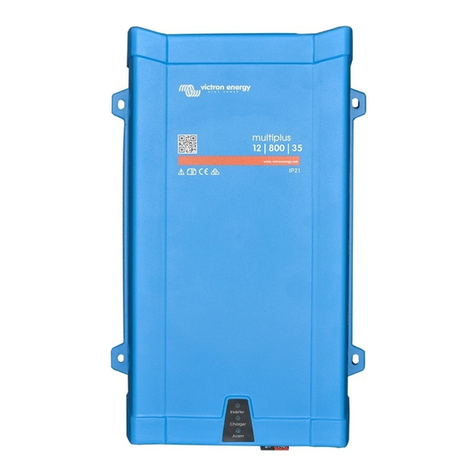
Victron energy
Victron energy MultiPlus 12/800/35 manual

Daikin
Daikin K-Series Service manual
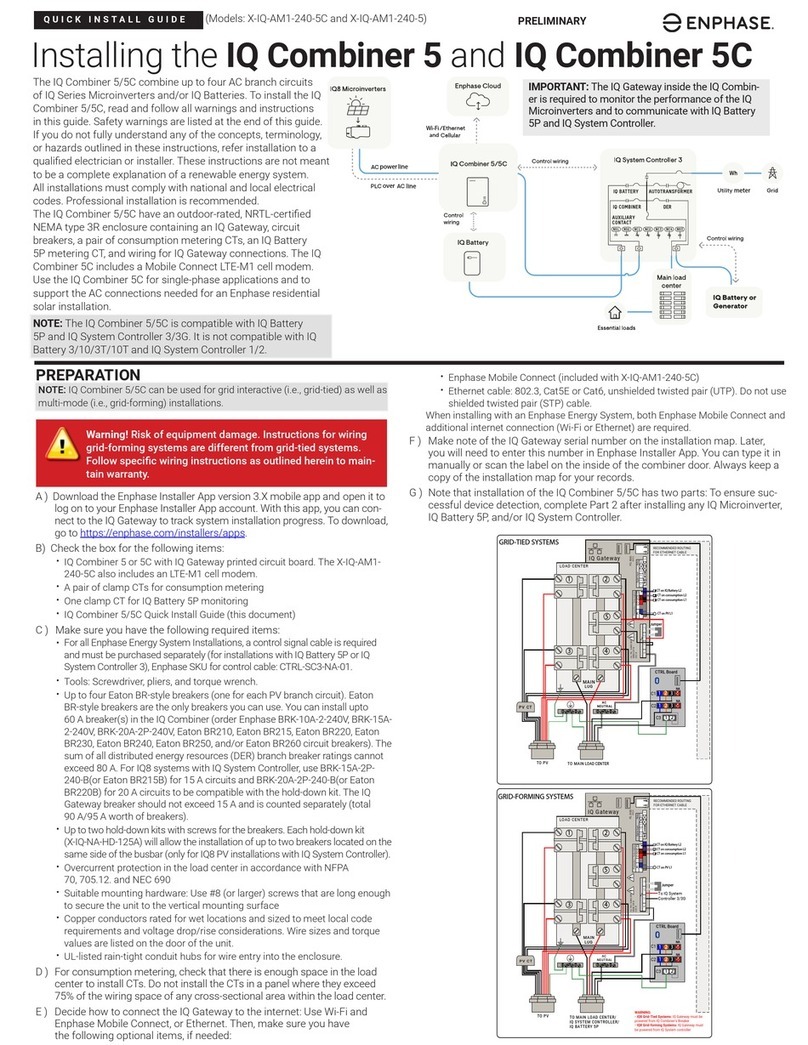
enphase
enphase IQ Combiner 5 Installing
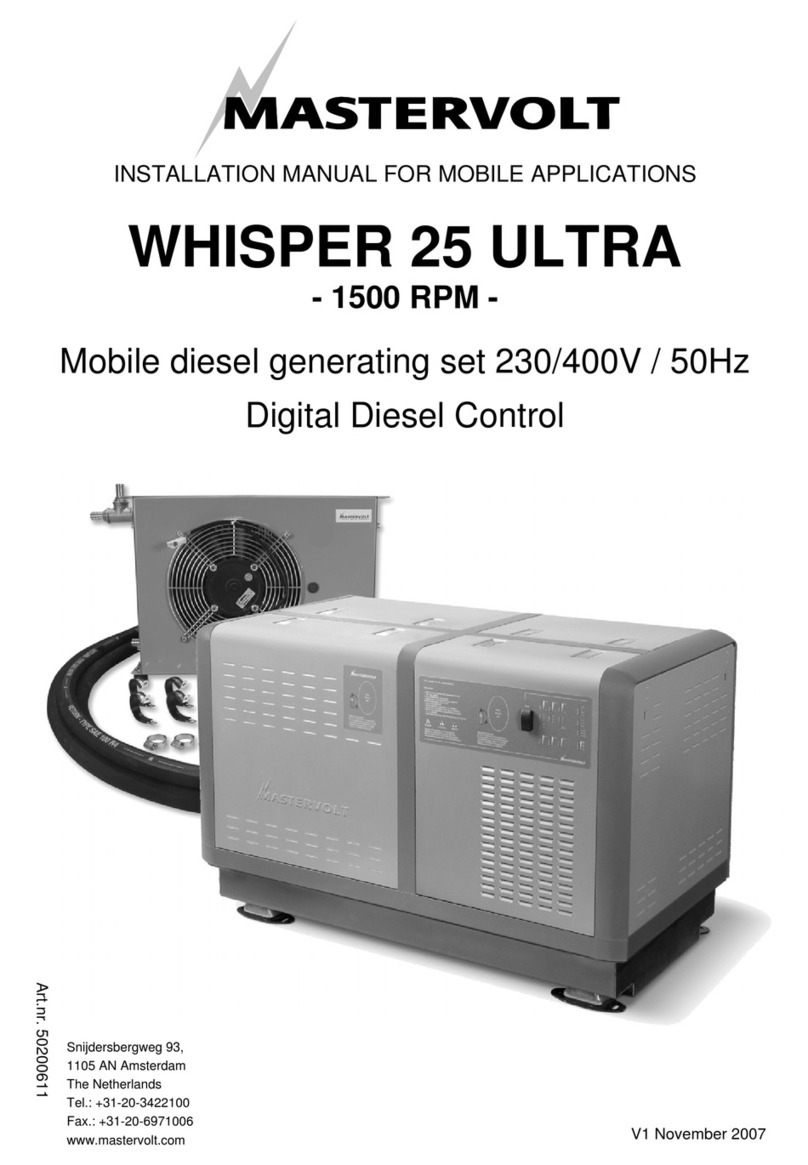
Mastervolt
Mastervolt WHISPER 25 ULTRA installation guide
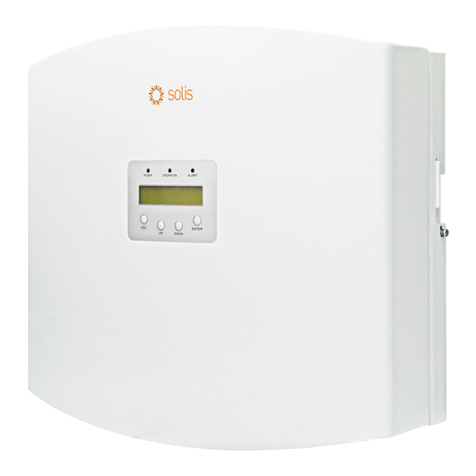
Ningbo Ginlong Technologies
Ningbo Ginlong Technologies Solis 5G Installation and operation manual

Sincro
Sincro EP260L Use and maintenance manual

Mitsubishi Electric
Mitsubishi Electric 700 Series INSTALLATION GUIDELINE
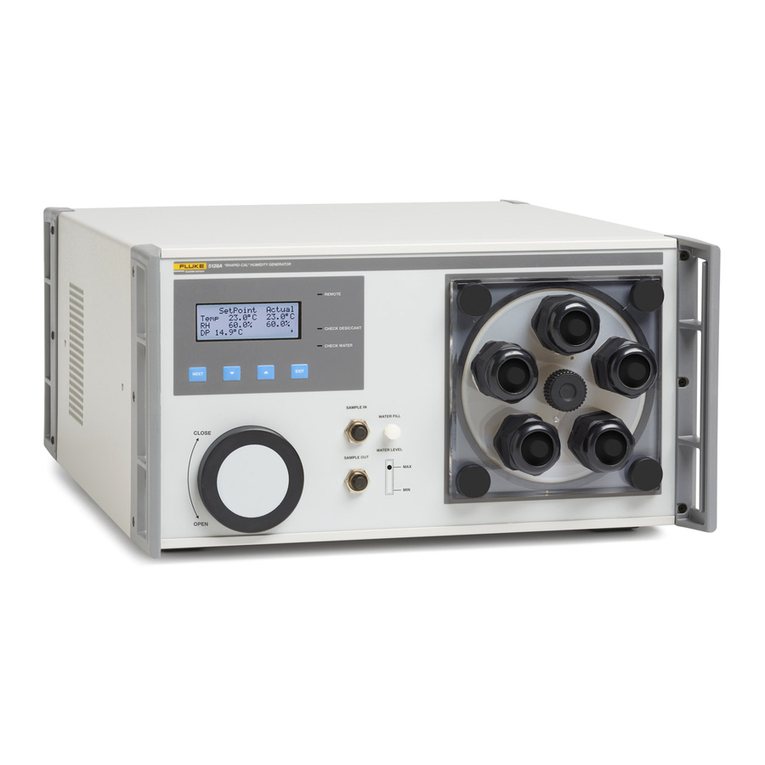
Fluke
Fluke 5128A manual

Mitsubishi Electric
Mitsubishi Electric 800 Series instruction manual
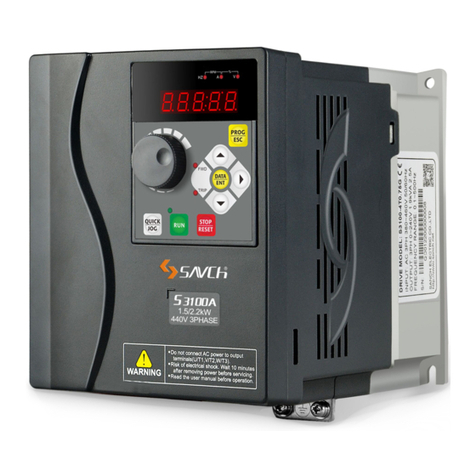
Savch
Savch S3100E Series user manual

Mitsubishi Electric
Mitsubishi Electric FR-A700 Series Installation guidelines
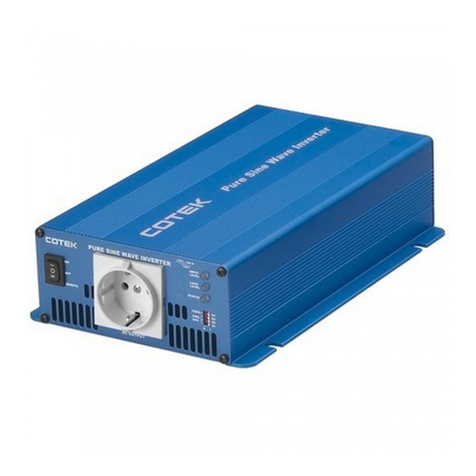
Cotek
Cotek SK700-112 user manual

